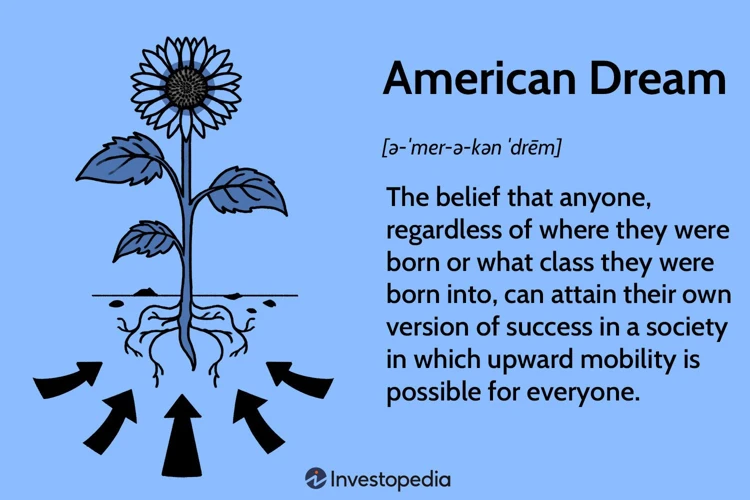For many, the American Dream is a enigmatic concept that holds both promise and intrigue. It is a symbol of hope, opportunity, and upward mobility. But what exactly is the American Dream? In this definitive interpretation guide, we will delve deep into its origins, explore various perspectives, and shed light on the challenges and redefinitions it has faced over time. Whether you are an American hoping to understand your own aspirations or someone from another part of the world curious about this national ethos, this comprehensive article will provide the answers you seek. So, fasten your seatbelts and prepare to embark on an illuminating journey through the intricacies of the American Dream.
What is the American Dream?

The American Dream is a complex and multifaceted concept that encompasses a wide range of aspirations and ideals. At its core, it represents the belief in the possibility of upward social mobility and the pursuit of a better life through hard work and determination. It is a dream of financial success, personal fulfillment, and the freedom to make choices that define one’s own destiny. The American Dream is often associated with the values of equality, opportunity, and the pursuit of happiness. It is a dream that has captured the imaginations of people around the world, inspiring millions to seek a better life in the land of opportunity. However, the American Dream is not without its critics and challenges. It has been subject to scrutiny and debate, with some questioning its attainability and others highlighting the disparities and inequalities that exist within society. In the next sections, we will explore the origins of the American Dream, its various interpretations, the challenges it faces, and the ways in which it has been redefined over time.
The Origins of the American Dream

The Origins of the American Dream can be traced back to the early days of American history, shaped by the ideals and principles of the Founding Fathers. The concept of the American Dream emerged as the nation was being established, with the aspiration for a society built on freedom, independence, and the pursuit of happiness. The idea of a land where anyone could rise above their circumstances and achieve success through hard work and perseverance became deeply ingrained in the American psyche. Immigration also played a pivotal role in shaping the American Dream, attracting people from all over the world who sought a better life and the opportunity to fulfill their dreams. This vision of a land of opportunity and upward social mobility has been explored and romanticized in various forms of literature and film, capturing the imagination of both Americans and people worldwide. The American Dream, therefore, has roots in the ideals of the founding of the nation and has been further enriched by the diversity of those who have sought to pursue it.
The Founding Fathers and the American Dream
The American Dream has its roots in the ideals and principles set forth by the Founding Fathers of the United States. These visionaries, including Thomas Jefferson, George Washington, and Benjamin Franklin, believed in the pursuit of liberty, equality, and opportunity for all individuals. They envisioned a society where hard work and merit would be rewarded, and where individuals had the freedom to shape their own destinies. The Founding Fathers’ commitment to the principles of independence and self-determination laid the groundwork for the American Dream. Their belief in the power of democracy and individual liberty continues to be at the heart of the American ethos, inspiring generations to strive for a better life and a brighter future. It is through their visionary leadership that the American Dream became ingrained in the collective consciousness of the nation, guiding the aspirations and ambitions of countless individuals who sought to make a better life for themselves and their families.
The Role of Immigration
The Role of Immigration has played a significant part in shaping and defining the American Dream throughout history. Immigrants have long been drawn to the United States in search of new opportunities and the chance to build a better life for themselves and their families. From the early European settlers who arrived in the 17th century to the waves of immigrants from all corners of the globe in the 19th and 20th centuries, the contributions of immigrants have been instrumental in shaping the American Dream. Immigrants have brought their skills, talents, and determination, enriching the cultural fabric of the nation and driving economic growth. They have played a vital role in building America’s infrastructure, starting businesses, and fueling innovation. While immigration has always been a contentious issue, with debates about assimilation, economic impact, and national identity, it is undeniable that immigrants have played a crucial role in the realization of the American Dream for countless individuals and have helped shape the nation into what it is today.
The American Dream in Literature and Film
The American Dream has served as a source of inspiration for countless works of literature and film. In these artistic mediums, the American Dream is often depicted through stories of individuals striving to overcome adversity and achieve their goals. From classic novels like F. Scott Fitzgerald’s “The Great Gatsby,” which explores the corrupting influence of wealth and the elusive nature of the American Dream, to films like “It’s a Wonderful Life,” which highlights the importance of community and personal values in finding fulfillment, these works capture the complexities and contradictions inherent in the pursuit of the American Dream. Through vivid imagery, compelling characters, and thought-provoking narratives, literature and film offer insights into the triumphs and tragedies experienced by those who embark on the journey towards their version of the American Dream. They provide a glimpse into the hopes, dreams, and struggles of individuals and the larger societal forces that shape their paths. By examining these artistic interpretations, we gain a deeper understanding of the ever-evolving nature of the American Dream.
Interpreting the American Dream

Interpreting the American Dream involves exploring different perspectives and understandings of this elusive concept. One common interpretation is the materialistic perspective, which emphasizes the acquisition of wealth, possessions, and social status as key components of achieving the American Dream. This perspective often associates success and happiness with financial prosperity and material comfort. Another interpretation revolves around the pursuit of happiness, emphasizing personal fulfillment, self-discovery, and the freedom to choose one’s own path in life. This perspective sees the American Dream as the pursuit of a fulfilling and meaningful existence, where individuals can pursue their passions and find joy in their daily lives. Additionally, social mobility and equality are frequently linked to the American Dream, with the belief that everyone should have the opportunity to better their circumstances and improve their social standing. This perspective emphasizes the importance of equal access to education, economic opportunities, and social resources for all members of society. Throughout history, these different interpretations have shaped the American Dream and influenced the aspirations and expectations of individuals pursuing it.
The Materialistic Perspective
The Materialistic Perspective of the American Dream emphasizes the acquisition of wealth, possessions, and social status as the ultimate measure of success. It is rooted in the belief that financial prosperity and material comforts are the key indicators of achieving the American Dream. This perspective places a strong emphasis on individualism, capitalist ideals, and the pursuit of financial gain. According to this viewpoint, success is defined by the ability to accumulate wealth, own property, and attain a high standard of living. However, critics argue that focusing solely on material wealth can lead to a shallow and unfulfilling existence, neglecting other important aspects of life such as relationships, personal growth, and well-being. As we delve deeper into the interpretations of the American Dream, we will explore alternative perspectives that challenge the purely materialistic view, offering a more holistic understanding of what it means to achieve the American Dream.
The Pursuit of Happiness
The Pursuit of Happiness is a central theme in the interpretation of the American Dream. It is the belief that individuals have the right to seek happiness and fulfillment in their lives, both personally and professionally. Rooted in the Declaration of Independence, which declares that all men are entitled to “life, liberty, and the pursuit of happiness,” this concept highlights the importance of individual freedoms and self-fulfillment. The pursuit of happiness encompasses a range of aspirations, including personal well-being, meaningful relationships, and the ability to pursue one’s passions and dreams. It is about finding joy and satisfaction in one’s work, relationships, and overall quality of life. However, the pursuit of happiness can vary greatly from person to person, as each individual may have their own unique definitions of what brings them joy and fulfillment. In a society that values individualism and personal choice, the pursuit of happiness is a fundamental aspect of the American Dream. It is the driving force behind many people’s dreams and ambitions, propelling them to strive for a better and more fulfilling life.
Social Mobility and Equality
Social mobility and equality are key components of the American Dream. Social mobility refers to the ability of individuals to move up the socioeconomic ladder, regardless of their social background. It embodies the idea that hard work and merit should be the primary factors determining success, rather than one’s starting point in life. Equality, on the other hand, emphasizes the principle of fairness and equal opportunities for all members of society. In the context of the American Dream, equality means that every individual should have the chance to achieve their goals and aspirations, regardless of their race, gender, or socioeconomic status. However, it is important to note that achieving true social mobility and equality remains a challenge in America. Income inequality and wealth disparity persist, creating barriers for many individuals to overcome. Racial and gender disparities also play a significant role in limiting access to opportunities and hindering social mobility. To fully realize the American Dream, efforts must be made to address these systemic inequalities and create a more equitable society for all. (Source: /dream-meaning-about-someone-died/)
Challenges to the American Dream

Challenges to the American Dream have emerged over time, casting doubt on the belief that hard work and opportunity alone can guarantee success and upward mobility. Income inequality and the wealth gap have become major obstacles, with the rich getting richer while many struggle to make ends meet. Racial and gender disparities persist, hindering equal access to opportunities. The 2008 financial crisis exposed the fragility of the American Dream, as many lost their homes and jobs, eroding trust in the system. These challenges have led to a growing sense of disillusionment and skepticism regarding the attainability of the American Dream. It is important to address these issues and find ways to ensure that the promise of the American Dream is not just an elusive fantasy, but a reality for all.
Income Inequality and Wealth Gap
Income inequality and the wealth gap pose significant challenges to the realization of the American Dream. It is a harsh reality that financial disparities exist within society, where a small percentage of individuals hold a disproportionate amount of wealth and resources. This unequal distribution of income creates barriers to social mobility and can hinder the ability of individuals to achieve upward economic mobility. The rich getting richer while the poor struggle to make ends meet is a stark reminder of the persistent divisions within society. Critics argue that this concentration of wealth widens the gap between the affluent and the disadvantaged, making it harder for those at the lower end of the socioeconomic ladder to improve their lives. The presence of income inequality raises important questions about the fairness and inclusivity of the American Dream, as it challenges the notion that hard work alone can lead to success and prosperity. It is a fundamental issue that needs to be addressed if we are to truly uphold the principles of opportunity and equality that the American Dream represents.
Racial and Gender Disparities
Racial and gender disparities have long been significant challenges to the realization of the American Dream. Despite the ideal of equal opportunity, systemic discrimination and prejudice have hindered marginalized communities from achieving the same level of success and upward mobility as their counterparts. Historically, racial minorities and women have faced barriers in accessing education, employment, and housing opportunities. This has perpetuated a cycle of inequality, limiting their ability to fully participate in and benefit from the American Dream. Efforts towards achieving racial and gender equality have made progress, but there is still work to be done. Society must continue to address systemic biases, promote diversity and inclusion, and create equal opportunities for all individuals to truly fulfill the promise of the American Dream.
The Impact of the 2008 Financial Crisis
The 2008 Financial Crisis had a significant impact on the American Dream and its perceived attainability. The crisis, triggered by the collapse of the housing market and the subsequent failure of major financial institutions, resulted in widespread job losses, foreclosures, and a decline in economic stability. Many individuals and families faced financial ruin, with dreams of homeownership, career advancement, and financial security shattered. The crisis exposed the vulnerabilities and flaws in the American economic system, leaving many questioning the fairness and viability of the American Dream. The effects of the crisis were felt for years, with long-lasting repercussions on the economy, employment prospects, and the overall well-being of individuals and communities. Despite efforts to recover and rebuild, the scars of the 2008 Financial Crisis continue to influence the perception and pursuit of the American Dream to this day.
Redefining the American Dream
Redefining the American Dream is an ongoing process that reflects the evolving values and aspirations of society. As we enter a new era, new dimensions are being added to the concept. One important aspect of redefining the American Dream is the growing emphasis on environmental sustainability. The pursuit of a better life is no longer solely focused on material possessions, but also on preserving and nurturing the planet we call home. Another facet of the redefined American Dream is the recognition of the importance of work-life balance and overall well-being. It is no longer just about financial success, but also about finding fulfillment and happiness in all aspects of life. Additionally, the idea of global citizenship is gaining prominence, highlighting the interconnectedness of our world and the importance of empathy, understanding, and collaboration on a global scale. As we strive to redefine the American Dream, we must recognize that it is a collective effort that requires individuals, communities, and nations to come together and envision a future that encompasses sustainability, well-being, and a sense of shared humanity.
Environmental Sustainability
Environmental sustainability is a growing concern that has become intrinsically linked to the American Dream. As society becomes more aware of the impact of human activities on the planet, there is a growing recognition that the pursuit of material wealth and success must be balanced with responsible stewardship of the environment. People are increasingly realizing that true fulfillment and prosperity cannot be achieved at the expense of the natural world. The American Dream is evolving to include a focus on sustainable practices, renewable resources, and conservation. It is not just about achieving personal and financial goals, but also about leaving a positive legacy for future generations. This shift in perspective is reflected in the efforts of individuals, communities, and businesses to embrace eco-friendly practices, reduce carbon emissions, and protect biodiversity. The dream of a prosperous and sustainable future is becoming intertwined with the broader aspirations of the American Dream, as people recognize the importance of preserving the planet for ourselves and for future dreamers.
Work-Life Balance and Well-being
Work-life balance and well-being have become increasingly important considerations in the modern interpretation of the American Dream. While financial success and career advancement have traditionally been seen as key components, there is a growing recognition that true fulfillment also comes from personal happiness and overall well-being. People are realizing that living the American Dream shouldn’t mean sacrificing their mental and physical health, relationships, and leisure time. The pursuit of a balanced life has gained prominence as individuals seek to prioritize self-care, quality time with loved ones, and meaningful experiences. This shift in perspective reflects a broader societal recognition that success should not be measured solely by material wealth, but by a holistic sense of fulfillment. As people strive to achieve their own unique versions of the American Dream, they are increasingly valuing work-life balance and prioritizing their well-being as intrinsic to their overall happiness and success.
Global Citizenship
Global citizenship is an emerging aspect of redefining the American Dream in the modern age. It goes beyond the traditional notions of success and material wealth, emphasizing a broader responsibility and interconnectedness with the global community. Global citizens view themselves as members of a global society, acknowledging the impact of their actions on a global scale. They prioritize environmental sustainability, social justice, and cultural understanding. Global citizenship encourages individuals to transcend national borders and contribute to the well-being of the world at large. By fostering empathy, promoting human rights, and addressing global challenges, global citizens strive to create a more just and equitable world. This shift in perspective reflects a growing recognition that the American Dream does not exist in isolation, but rather exists within a global context where individual dreams intersect with collective aspirations. Embracing global citizenship allows individuals to broaden their horizons, expand their impact, and contribute to a shared vision of a better future.
Link to anchor: dream of
Conclusion
In conclusion, the American Dream remains a powerful and enduring concept that continues to shape the aspirations and dreams of individuals across the nation and beyond. It is a symbol of hope, opportunity, and the pursuit of a better life. Throughout history, the American Dream has evolved and adapted to reflect the changing socio-economic landscape, as well as the challenges and inequalities that have arisen. While there are obstacles and criticisms to navigate, the dream of achieving success, happiness, and personal fulfillment remains a driving force for many. As we continue to redefine and interpret the American Dream in the face of contemporary issues such as environmental sustainability, work-life balance, and global citizenship, it is clear that its essence, the belief in the possibility of a better future, will continue to inspire generations to come. So, whether you are an immigrant seeking a fresh start, a hardworking individual striving for success, or simply someone fascinated by the intricacies of this national ethos, the American Dream will always be a captivating and enduring concept in our collective consciousness.
Frequently Asked Questions
1. What are the origins of the American Dream?
The American Dream has its roots in the founding principles of the United States, which emphasized individual liberty, equal opportunity, and the pursuit of happiness. It emerged as a concept during the early days of American colonization and gained prominence through the writings of early political thinkers and philosophers.
2. How has immigration shaped the American Dream?
Immigration has played a significant role in shaping the American Dream. Throughout history, millions of immigrants have come to America in search of better economic opportunities, social mobility, and the chance to build a prosperous future for themselves and their families. They have contributed to the diverse fabric of American society and helped fuel the country’s economic growth.
3. How is the American Dream portrayed in literature and film?
Literature and film have frequently depicted the American Dream as a central theme. From F. Scott Fitzgerald’s “The Great Gatsby” to movies like “The Pursuit of Happyness,” these works explore the pursuit of success, wealth, and happiness, while also critiquing the challenges and limitations of achieving the American Dream.
4. What is the materialistic perspective of the American Dream?
In the materialistic perspective, the American Dream is often equated with financial success, homeownership, and the accumulation of material possessions. It focuses on the pursuit of wealth and the belief that hard work and determination will lead to prosperity and social mobility.
5. How does the American Dream relate to the pursuit of happiness?
The American Dream views the pursuit of happiness as an inherent right and a fundamental aspect of the dream itself. It emphasizes the freedom to choose one’s own path, engage in fulfilling work, and live a life that aligns with personal values and aspirations.
6. What is the relationship between social mobility and the American Dream?
Social mobility is closely tied to the American Dream, as it represents the ability to move up the social ladder regardless of one’s background. The idea is that individuals have the opportunity to improve their socioeconomic status through hard work, education, and merit, creating a society where success is not solely determined by birthright.
7. What are the challenges to the American Dream?
The American Dream faces numerous challenges, including income inequality and the wealth gap, which can hinder upward mobility for many individuals. Additionally, racial and gender disparities, as well as the impact of events like the 2008 financial crisis, have highlighted systemic barriers and limitations to achieving the dream.
8. How does the American Dream intersect with environmental sustainability?
With increasing awareness of environmental issues, there is a growing conversation about redefining the American Dream to incorporate environmental sustainability. This includes promoting eco-friendly practices, renewable energy, and sustainable development to ensure a better future for generations to come.
9. What is the significance of work-life balance and well-being in the American Dream?
As the American Dream evolves, there is a greater emphasis on the importance of work-life balance and overall well-being. People are recognizing the need to prioritize personal happiness, mental health, and quality time with loved ones, rather than solely focusing on material wealth and professional success.
10. How can global citizenship be seen as part of the modern American Dream?
As the world becomes more interconnected, global citizenship is increasingly considered a component of the American Dream. This includes promoting empathy, cultural understanding, and active participation in global issues, recognizing that a better future for all relies on a collective effort.







